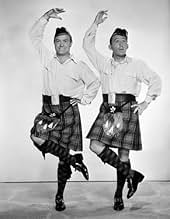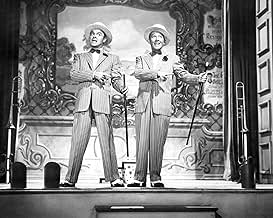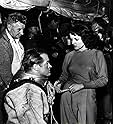NOTE IMDb
6,4/10
5,4 k
MA NOTE
Ajouter une intrigue dans votre langueTwo unemployed show-biz pals accept treasure-diving work in Bali for a local princess and they find treasure, love and trouble.Two unemployed show-biz pals accept treasure-diving work in Bali for a local princess and they find treasure, love and trouble.Two unemployed show-biz pals accept treasure-diving work in Bali for a local princess and they find treasure, love and trouble.
- Réalisation
- Scénario
- Casting principal
Michael Ansara
- Guard
- (non crédité)
Besmark Auelua
- Lesser Priest
- (non crédité)
John Barton
- Audience Member
- (non crédité)
Phil Bloom
- Unemployed Man
- (non crédité)
Humphrey Bogart
- Charlie Allnut
- (images d'archives)
- (non crédité)
Pat Borella
- Dancer
- (non crédité)
George Bruggeman
- Warrior
- (non crédité)
Robert Cabal
- Native
- (non crédité)
Steve Calvert
- Gorilla
- (non crédité)
Herman Cantor
- Priest
- (non crédité)
Sue Casey
- Handmaiden
- (non crédité)
Avis à la une
And, it was the only one of the "Road to..." movies that he and Bing Crosby ever did in Technicolor. The ad-libbed asides to the audience were something I had never seen or heard of before! Even more of a delightful surprise was the cameo appearance by General Burkhalter as a South Sea island chief!! The songs weren't bad, either. * "The Merry-Go-Run-Around" is probably my second-favorite song of Bob's. "Silver Bells" and "Thanks for the Memories" naturally tie for first-place.* With Bob having died this past Sunday, nostalgia channels like AMC and TCM will no doubt include this, and all his other films, in some kind of marathon movie memorial. *Which they really should have done BACK ON HIS CENTENNIAL!* Oh, well. Thanks to you, Bob, for all my merry, mirth-filled memories.
I like all of the Hope and Crosby road pictures even if they were kind of silly. I grew up with them; even saw Hope on stage at the Palace Theater in Cleveland, Ohio in the old vaudeville days (they also had a picture show). Anyhow, as simple as they were, they were funny in their own way, and I loved Crosby singing, and Dorothy Lamour's vocaling in amour! Saw The Road to Bali on the tube AMC for the umpteenth time, and still enjoyed it; as usual the music is great, and the boys really didn't know how to end it! 6/10
On a scale of one to a million this rates about a 999,999 on the silly scale. In colour and with beautiful production values ROAD TO BALI made in 1952 contains as many up to date movie and social references as an encyclopedia written by Ludwig Von Drake. In a huge theatre these ROAD films must have lifted the roof with laughter, and as a DVD diversion in 2006 any of them can be a generous and loony mood lifter. There is actually many laugh out loud moments still to be had even if you weren't born or aware of life in the early 50s. THE ROAD TO BALI (pronounced "Bally" by Americans; "Barley" by the rest of us) is basically flat-out hilarious with quips and ad libs galore. Even if you cringe at Bing Crosby as I do, there is enough genuinely funny lines and situations and terrible gags to overwhelm you...much like THE PRODUCERS released this year insists we find it relentlessly dementedly funny. To me Bob Hope has always been Daffy Duck (Groucho Marx was Bugs Bunny) and it is his vaudeville lunacy that carries Crosby inbetween squabbling over Lamour and pushing through all parts of the set. This film has some excellent special effects, very admirable for '52. A hilarious cameo from Jane Russell is the cherry on the icing. Some big dance scenes are an added bonus. Fun fun and demented fun. What a year 1952 was for hilarious films (look 'em up).
ROAD TO BALI (Paramount, 1952), directed by Hal Walker, reunites the famous trio of Bing Crosby, Bob Hope and Dorothy Lamour in another wild and crazy adventure for their sixth "Road" outing. Having traveled through "Singapore" (1940), "Zanzibar" (1941), "Morocco" (1942), "Utopia" (1945) and finally "Rio" (1947), with a lot of other territories to explore such as Borneo, Venice or even outer space, the writers came up with "Bali" as their next stop. With newfound surroundings, added Technicolor and surprise guest stars along the way, the material supplied, though hardly original, was no doubt quite popular in its day.
Opening with a commentary and visual over the map of Australia leading to the city in Melbourne, the story gets underway in a vaudeville house where American entertainers, George Cochran (Bing Crosby) and Harold Gridley (Bob Hope), longtime pals, are performing. Back stage are a couple of angry fathers with their daughters to whom these guys proposed, but each having no intention of marrying. Making their getaway, they soon end up on a train from which they jump out to avoid another angry father, ending up in a far away place surrounded by sheep. Arriving in another city as part of a cargo of sheep, the bearded George and Harold agree to accept jobs from Ken Ahok (Mervyn Vye) working as deep sea divers (with Harold doing the underwater job) to help locate buried treasure. Upon their arrival on an island paradise, the boys encounter Ahok's cousin, Lalah (Dorothy Lamour), a princess of Scottish descent. Because Ken Ahok happens to be responsible for the deaths of his previous divers, with intention of doing the same for these Americans, Lalah warns them that their mission means certain death. After Harold dives for and acquires the buried jewels, the trio break away from Ahok's murderous cutthroats and set sail out for Bali. While on the tropical island, further danger and numerous surprises awaits.
A movie being more fantasy than its intended South Seas island spoof, the film's best moments are its opening 20 minutes. In spite of every effort made turning out a great 91 minute comedy in the tradition of ROAD TO MOROCCO or ROAD TO UTOPIA, this latest "Road" installment grows tiresome long before it's all over. Crosby the con man, Hope the stooge, and Lamour the sarong girl in the middle, revive their past "Road" adventures with much familiarity, continue acting like over-age kids with their one "paddy cake" routine along with an assortment of ad-libs. In-jokes are put to the maximum this time around, some at a total loss for viewers today. Best bits however, are Hope and Crosby surrounded by beautiful maiden girls. An agonizing groan is heard off screen: Crosby: "What was that?" Hope: "It's Errol Flynn. He can't stand it." Or a clip insertion of Humphrey Bogart hauling The African Queen. (I thought Bali is in Indonesia!) Then there's Bing Crosby's brother Bob doing his bit with a "shot in the picture," along with Dean Martin and Jerry Lewis, as well as Jane Russell in some amusing bits. There's also a running gag throughout the film where the boys play a flute to see what slowly grows out of the basket. Murvyn Vye makes a fine villain, but it would have been nice having Anthony Quinn ("Singapore" and "Morocco") back for old times sake.
Musical interludes are a tradition in the series, with new score by Johnny Burke and James Van Heusen, including: "Chicago Style" (sung by Bing Crosby and Bob Hope); "Moonflowers" (sung by Dorothy Lamour); "Hoot-Mon" (sung by Hope and Crosby in kilts, performed by handmaidens and warriors); "To See You" (sung by Crosby); "The Merry-Go-Round Around" (sung by Bob Hope, Dorothy Lamour and Bing Crosby); "Moonflowers" (reprize by Lamour); and "Wedding Chant" (natives). For Crosby's solo, Hope faces the camera addressing the theater audience that it's time for them to step out and get some popcorn.
Having fallen to public domain, poor quality prints of ROAD TO BALI have turned up on home video and DVD over the years. Better prints available happen to come from cable channels American Movie Classics and Turner Classic Movies. Being a Paramount film, notice the TCM print with both Columbia and Paramount studio logos for its introduction.
ROAD TO BALI almost became the final "Road" adventure. Ten years later, an attempt was made to revive the formula, being THE ROAD TO HONG KONG (United Artists, 1962), starring Crosby and Hope with Lamour strangely reduced to cameo appearance. Overall, any movie that can make a "monkey" out of Bob Hope, can't be all bad. (***)
Opening with a commentary and visual over the map of Australia leading to the city in Melbourne, the story gets underway in a vaudeville house where American entertainers, George Cochran (Bing Crosby) and Harold Gridley (Bob Hope), longtime pals, are performing. Back stage are a couple of angry fathers with their daughters to whom these guys proposed, but each having no intention of marrying. Making their getaway, they soon end up on a train from which they jump out to avoid another angry father, ending up in a far away place surrounded by sheep. Arriving in another city as part of a cargo of sheep, the bearded George and Harold agree to accept jobs from Ken Ahok (Mervyn Vye) working as deep sea divers (with Harold doing the underwater job) to help locate buried treasure. Upon their arrival on an island paradise, the boys encounter Ahok's cousin, Lalah (Dorothy Lamour), a princess of Scottish descent. Because Ken Ahok happens to be responsible for the deaths of his previous divers, with intention of doing the same for these Americans, Lalah warns them that their mission means certain death. After Harold dives for and acquires the buried jewels, the trio break away from Ahok's murderous cutthroats and set sail out for Bali. While on the tropical island, further danger and numerous surprises awaits.
A movie being more fantasy than its intended South Seas island spoof, the film's best moments are its opening 20 minutes. In spite of every effort made turning out a great 91 minute comedy in the tradition of ROAD TO MOROCCO or ROAD TO UTOPIA, this latest "Road" installment grows tiresome long before it's all over. Crosby the con man, Hope the stooge, and Lamour the sarong girl in the middle, revive their past "Road" adventures with much familiarity, continue acting like over-age kids with their one "paddy cake" routine along with an assortment of ad-libs. In-jokes are put to the maximum this time around, some at a total loss for viewers today. Best bits however, are Hope and Crosby surrounded by beautiful maiden girls. An agonizing groan is heard off screen: Crosby: "What was that?" Hope: "It's Errol Flynn. He can't stand it." Or a clip insertion of Humphrey Bogart hauling The African Queen. (I thought Bali is in Indonesia!) Then there's Bing Crosby's brother Bob doing his bit with a "shot in the picture," along with Dean Martin and Jerry Lewis, as well as Jane Russell in some amusing bits. There's also a running gag throughout the film where the boys play a flute to see what slowly grows out of the basket. Murvyn Vye makes a fine villain, but it would have been nice having Anthony Quinn ("Singapore" and "Morocco") back for old times sake.
Musical interludes are a tradition in the series, with new score by Johnny Burke and James Van Heusen, including: "Chicago Style" (sung by Bing Crosby and Bob Hope); "Moonflowers" (sung by Dorothy Lamour); "Hoot-Mon" (sung by Hope and Crosby in kilts, performed by handmaidens and warriors); "To See You" (sung by Crosby); "The Merry-Go-Round Around" (sung by Bob Hope, Dorothy Lamour and Bing Crosby); "Moonflowers" (reprize by Lamour); and "Wedding Chant" (natives). For Crosby's solo, Hope faces the camera addressing the theater audience that it's time for them to step out and get some popcorn.
Having fallen to public domain, poor quality prints of ROAD TO BALI have turned up on home video and DVD over the years. Better prints available happen to come from cable channels American Movie Classics and Turner Classic Movies. Being a Paramount film, notice the TCM print with both Columbia and Paramount studio logos for its introduction.
ROAD TO BALI almost became the final "Road" adventure. Ten years later, an attempt was made to revive the formula, being THE ROAD TO HONG KONG (United Artists, 1962), starring Crosby and Hope with Lamour strangely reduced to cameo appearance. Overall, any movie that can make a "monkey" out of Bob Hope, can't be all bad. (***)
Trying to avoid shotgun weddings, two entertainers (Bob Hope, Bing Crosby) run away and take jobs as deep sea divers. This leads them to Bali and princess Dorothy Lamour. Inevitably both guys vie for Dorothy's affections while tangling with bad guys and a giant squid.
Routine 'Road' picture with the notable difference of it being in color. Hope and Crosby are always fun, especially when they break the fourth wall. Lamour is lovely in color. This was her last film for ten years. Some of the gags are tired but there are still lots of yuks. Also some decent songs. Overall the likable personalities of the trio keep it afloat. Jane Russell, Martin & Lewis, and Humphrey Bogart (through African Queen footage) all have cameos. There is one rather odd sequence where Dorothy dreams of her childhood pet monkey and we see a real chimp wearing a very creepy Bob Hope mask.
Routine 'Road' picture with the notable difference of it being in color. Hope and Crosby are always fun, especially when they break the fourth wall. Lamour is lovely in color. This was her last film for ten years. Some of the gags are tired but there are still lots of yuks. Also some decent songs. Overall the likable personalities of the trio keep it afloat. Jane Russell, Martin & Lewis, and Humphrey Bogart (through African Queen footage) all have cameos. There is one rather odd sequence where Dorothy dreams of her childhood pet monkey and we see a real chimp wearing a very creepy Bob Hope mask.
Le saviez-vous
- AnecdotesIn her 1980 autobiography, "My Side of the Road," (co-written with Dick McInnes), Dorothy Lamour relates how disappointed she was at not being asked to sing on the Decca album, which re-created the film score in the recording studio. Her umbrage was largely in response to learning that it was Bing Crosby himself who recruited Peggy Lee to replace her.
- GaffesWhen the widowed ape is holding George (Crosby) in her lap, Crosby's socks switch between red in one shot and pale yellow in the next shot. Skipping back and forth - the scene must have been filmed over more than one day.
- Citations
Harold Gridley: He's gonna sing, folks. Now's the time to go out and get the popcorn.
- Crédits fousIn the end, Harold Gridley is trying to get rid of the "The End" text, but it wouldn't go away. When it faded to black it reads "Positively The End".
- ConnexionsEdited into Your Afternoon Movie: Road to Bali (2022)
Meilleurs choix
Connectez-vous pour évaluer et suivre la liste de favoris afin de recevoir des recommandations personnalisées
- How long is Road to Bali?Alimenté par Alexa
Détails
- Durée1 heure 31 minutes
- Couleur
- Rapport de forme
- 1.37 : 1
Contribuer à cette page
Suggérer une modification ou ajouter du contenu manquant

Lacune principale
By what name was En route vers Bali (1952) officially released in India in English?
Répondre

































